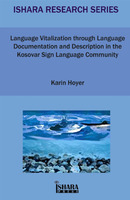Language Vitalization through Language Documentation and Description in the Kosovar Sign Language Community
Abstract
This study on language vitalization and community empowerment in the Kosovar sign language community focuses on linguistic work taking place within the framework of a development co-operation project between two NGOs in Kosovo and Finland. The long-term objectives were to improve the status of Kosovar Sign Language (KosSL) and to guarantee the human (linguistic) rights of Deaf language users – for them to obtain access to society on an equal basis with other citizens. This was implemented through lobbying for legal recognition of KosSL and by advocacy work directed at governmental authorities.
One of the central activities in the project was to conduct basic documentation and description of KosSL, and provide linguistic training for representatives of the sign language community.
The study has implications for similar language vitalization work in sign language communities, including the importance of raised language awareness, involving the whole community, and Deaf role models in the implementation of the work. Methodological issues dealt with a range of different topics; from the relationship between the language community and the outside advisor, to language use and everyday working methods. Partnership-enhancing methods had a significant influence on the success of the project, and resulted in community members’ ownership of the work.
Keywords
braille and other communication; language documentation; kosovo; deafness; deaf community; sign language; Deaf education; Deaf-community sign language; Endangered language; Hearing loss; LinguisticsDOI
10.26530/OAPEN_442947ISBN
9789086560004Publisher
Ishara PressPublication date and place
Nijmegen, 2013Series
Ishara Research Series, 1Classification
Sign languages, Braille and other linguistic communication


 Download
Download Web Shop
Web Shop